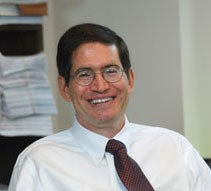Professor Michael Klarman, a constitutional law and history scholar, joined the faculty earlier this year after a distinguished tenure at the University of Virginia since 1987. He is the author of “From Jim Crow to Civil Rights: The Supreme Court and the Struggle for Racial Equality,” winner of the 2005 Bancroft Prize, and, more recently, “Unfinished Business: Racial Equality in American History,” which was published in 2007.
You suggest in “Unfinished Business” that the history of American race relations shows slow and episodic progress. How does the Obama presidential nomination fit in?
The current state of American race relations is enormously complex. Twenty years ago, I don’t think many people could have imagined that the first two secretaries of state of the 21st century would be African-American or that a black man had a serious chance of being elected president in 2008. On the other hand, the condition of the black urban underclass is worse today than it was 20 years ago: These people are poorer; they are more likely to be incarcerated; their life expectancy is lower; their economic circumstances are worse than they were a couple of decades ago. And one of the complexities of American racial politics is that presidential candidate Obama dare not discuss those issues too candidly for fear of pigeonholing himself as the “black” candidate.
You also noted that the light Hurricane Katrina shed on the problems of the African-American urban underclass quickly dimmed. What explains how that issue receded?
American history suggests that effective crusades for racial justice happen intermittently, usually in the aftermath of war, and that public commitment to them is fleeting. Reconstruction was largely a product of the role played by African-American soldiers in preserving the Union, and most Northerners lost their enthusiasm for it by the mid-1870s, enabling white Southerners to “redeem” their states from Reconstruction and largely nullify the Civil War amendments to the Constitution. The civil rights movement of the 1960s was partly a function of the Cold War imperative for racial justice—the need for Americans competing with the Soviet Union for the allegiance of nonwhite Third World countries to demonstrate that democratic capitalism was not synonymous with white supremacy. By the late 1960s, the Vietnam War, urban race riots, the rise of the black power movement, and the shifting focus of the civil rights movement to issues of economic redistribution caused many Americans to lose enthusiasm for the movement. The rapid loss of focus on the plight of the black urban underclass after Katrina simply confirms how difficult it is, absent extraordinary circumstances, to maintain public support for racial justice.
What’s the state of school desegregation in the wake of the Supreme Court’s 2007 decision? Is that the end of the school desegregation story?
The nation’s 50-year experiment with school desegregation was largely over before the conservative justices on the Supreme Court attempted to kill it in 2007. Public support for aggressive school integration policies has never been strong but surely had collapsed by the 1980s. The Rehnquist Court reflected that public opinion in a couple of rulings in the early 1990s, which erected substantial hurdles to maintaining court-mandated desegregation policies and clearly hinted that lower courts should begin winding up desegregation decrees. In 2007, the Court went further, barring even voluntary school board efforts to promote integration through race-conscious measures. The ruling was breathtaking, coming from justices who purport to be committed to judicial restraint, federalism and an originalist methodology of constitutional interpretation (given that no credible account of the original understanding of the 14th Amendment establishes government color blindness as its objective). Yet the ruling had relatively little practical effect because so few school districts—probably only 5 to 10 percent of those in the country—employed voluntary integrationist measures by 2007.
You taught a seminar on the Warren Court last spring. Did preparing for or teaching the class change the way you think about the Warren era?
I had no idea of the extent to which Barry Goldwater tried to make the Court and its criminal procedure rulings an issue in the 1964 election. His landslide defeat might well have emboldened the justices to decide cases like Miranda v. Arizona (1966) the way they did. I also learned a lot about the ways in which different justices try to “market” their decisions to the public. In the Bible reading case Abingdon School District v. Schempp (1963), Justice Brennan tries to minimize the implications of the Court’s ruling for other public religious observances, whereas Justice Douglas seems determined to read the ruling in the broadest possible fashion, including invalidation of the motto “In God We Trust.” I also emerged with a better sense of individual justices and their relationships. I had not quite realized the depth of the animosity between Douglas and Frankfurter. And I had not fully appreciated the extent to which Justice Black had soured on the civil rights movement by the early 1960s.
Your next book will explore the backlash generated by high-profile cases like Brown v. Board of Education and the Massachusetts same-sex marriage ruling in 2003. Why do judges regularly seem surprised by strong reactions to their decisions?
On culture war issues like abortion and gay rights, people on different ends of the socioeconomic spectrum, on average, hold vastly different views. Almost by definition, the justices occupy the elite end of that spectrum. I think this probably has disabled them from appreciating how ordinary people might feel about the abolition of capital punishment in 1972, invalidation of almost all abortion restrictions in 1973 and gay marriage in 2003.
